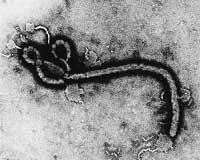Advances in Ebola knowledge and treatment
2014/08/29 Galarraga Aiestaran, Ana - Elhuyar Zientzia Iturria: Elhuyar aldizkaria
The World Health Organization has just presented a project to curb the Ebola outbreak in West Africa. It has a clear objective: to stop the transmission of the disease in countries where the outbreak has occurred for 6-9 months and to prevent its extension to other countries. For this reason, international cooperation has been considered essential.

He has confessed that it is the most serious manifestation in history. According to the WHO, more than 3,000 infections have been detected and 1,400 deaths have occurred. In addition, the virus has affected more health workers and researchers than so far. For example, five authors of the article recently published by the journal Science on the genetic sequence of the virus have died from Ebola.
The article explains the evolution of the virus genome. In fact, 99 viruses have been sequenced from 78 patients in Sierra Leone, who have revealed the mutations suffered during the outbreak when transmitted from one person to another, as well as those produced inside the person. At the same time, they have seen that the appearance has had a single origin, that is, that only one day has passed the virus of a bat (which are the deposits of the virus) to a person. Other infections have occurred from person to person.
According to the researchers, the virus genome is changing with some speed and they believe that it is important to keep track of the evolution to improve the diagnosis, since it may be necessary to renew the tests.
In addition, it has been proposed to sequence more viruses, since they believe that it is possible to know the behavior of the virus through the comparison of genomes, for example, to disseminate the degree of lethality or the ease it has.
Treatment, getting closer
The journal Nature has also published a study on Ebola. Precisely in rhesus macaques, they have shown that a combination of monoclonal antibodies (ZMapp) is effective in curing Ebola. Specifically, researchers from Canada and the United States have collaborated and managed to cure the rhesus makako used in the research, eighteen. The result is unbeatable, especially considering that treatment began within five days of infection, since macaques already had severe symptoms of the disease.
It is explained that for the development of the ZMapp researchers have been based on other treatments that have been used previously. These treatments also used monoclonal antibodies, but their effectiveness was limited. Now they seem to have invented a perfect combination.
Researchers recall that this same ZMapp was used to treat two American healers who had Ebola, although its variant was another. In view of the recovery of both, and the results of the experiment with macaques, researchers hope that soon clinical trials will begin so that there is safe and effective treatment against Ebola as soon as possible.

Gai honi buruzko eduki gehiago
Elhuyarrek garatutako teknologia







